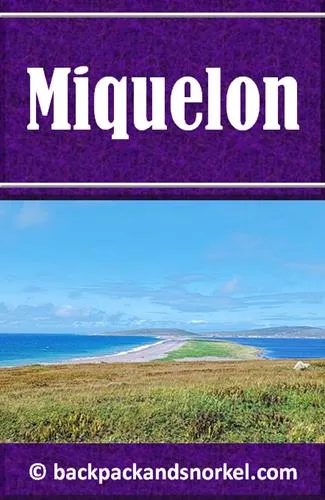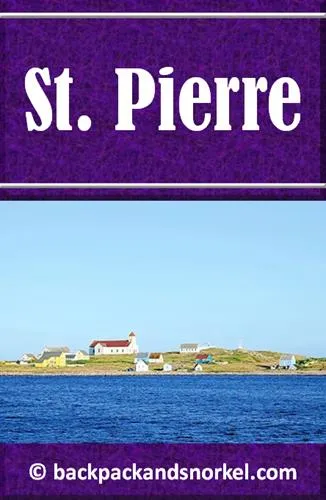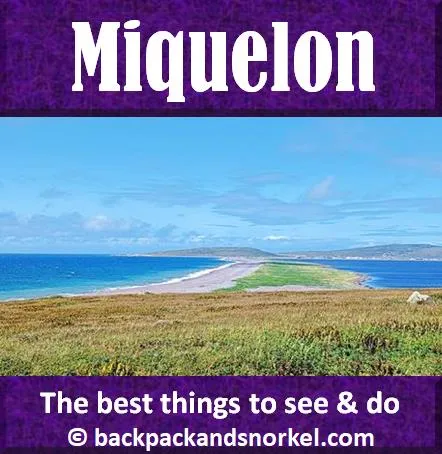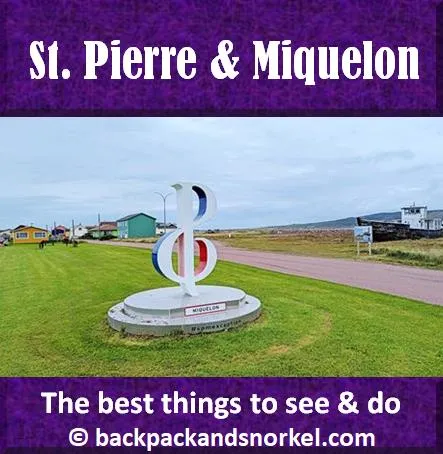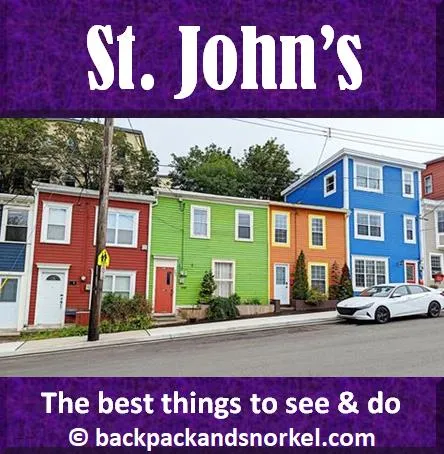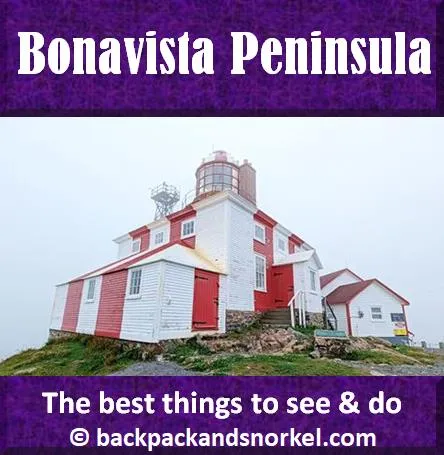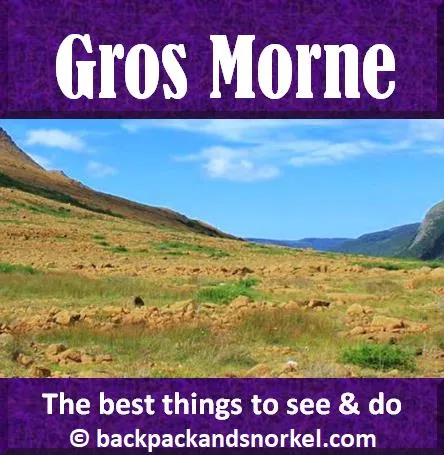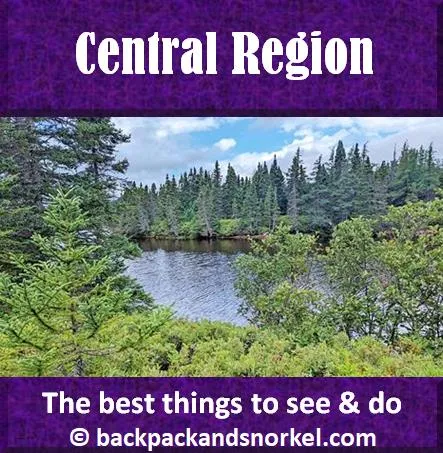Backpack and Snorkel Travel Guide for St. Pierre and Miquelon - St. Pierre and Miquelon Purple Travel Guide
The islands of St. Pierre and Miquelon are the last remnants of the former French colonial empire in North America. We provide detailed information and a self-guided tour with the best things to see and we show lots of photos so you know what you can expect.
Did you know that France is only a short ferry ride away from Canada?
The islands of St. Pierre and Miquelon are only a few miles off the coast of Newfoundland. Both islands have retained their French identity and culture. You can enjoy authentic French cuisine, buy French products, and speak French with the locals.
If you are into hiking, there are gorgeous hiking trails and no bears or other predatory mammals on the islands.
Just be advised that most people will need a passport to visit the islands and the Euro is the official currency. But don’t worry, credit cards are accepted almost everywhere.
St. Pierre is denser populated than Miquelon, but the population density on both islands is low and you will be able to experience beautiful nature.


Table of contents
General Information about St. Pierre and Miquelon |
Itinerary for your St. Pierre and Miquelon visit |
Discovering Miquelon |
Discovering St. Pierre |
Trip to St. John’s |
General Information about St. Pierre and Miquelon
How much time do you need to visit St. Pierre and Miquelon?
To explore the islands St. Pierre and Miquelon, you will need about 5 days – two days for Miquelon and 3 for St. Pierre.
Using the ferries from Fortune, Canada, it is not possible to see the islands in one day. It is, however, possible but not recommended to explore Miquelon on a day trip from St. Pierre.
We have integrated a 5-day trip to St. Pierre and Miquelon into our Newfoundland itinerary (see here), and we have prepared a stand-along itinerary for both islands (see here).
What is the best time to visit St. Pierre and Miquelon?
The best time to visit St. Pierre and Miquelon is July - August: This is the peak tourist season in St. Pierre and Miquelon. August is the warmest (average high: 67F, 20C). The warm Gulf Stream and the cold Labrador current meet near the islands and cause frequent rain or snow and fog throughout the year.
There is a short shoulder season in June and September.
From October through May, the number of visitors drop exponentially and many of the few tourist facilities on the islands close.
Below is the climate that you can expect on your trip to St. Pierre and Miquelon:
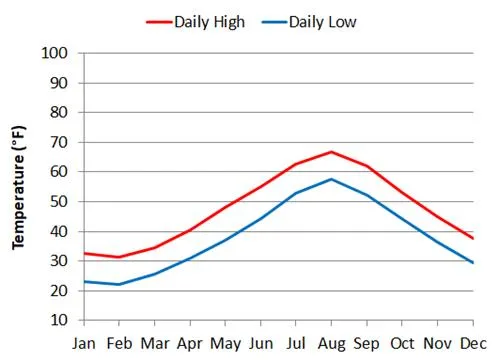

The highlights of the history of St. Pierre and Miquelon
- Approx.2000 BC: The Dorset culture begins settling Newfoundland and occasionally visits St. Pierre and Miquelon, but they do not build any permanent settlements
- 1520: Portuguese explorer João Álvares Fagundes lands on the islands and names them the Eleven Thousand Virgins, because the day marked the feast day of St. Ursula and her virgin companions
- 1536: French explorer Jacques Cartier claims the islands for France
- 1670: The islands have 4 permanent residents and are called Saint Pierre and Miquelon
- 1691: The islands have 22 permanent residents
- 1688 - 1697: During the Nine Years' War (King William's War), the islands are attacked several times by the British
- 1702 - 1713: During the French and Indian Wars (Queen Anne's War), the islands are attacked several times by the British
- 1713: Under the Treaty of Utrecht, France cedes the islands to Britain. England renames Saint Pierre to Saint Peter and British colonists begin to settle on the islands. Some of the French settlers swear allegiance to Britain, and remain on the islands
- 1763: In the Treaty of Paris, Britain cedes the islands of St. Pierre and Miquelon to France and France gets fishing rights on Newfoundland’s west coast
- 1763 – 1778: The islands become a refuge for Acadian deportees from Nova Scotia
- 1767: France determines that the islands are too small and too poor for the Acadians and moves them back to France
- 1768: The French government changes its mind and sends the Acadians back to St. Pierre and Miquelon
- 1778: The islands are conquered by the British and the colonists deported to France and their settlements burned.
- 1783: After the Peace of Paris, France regains the islands and some residents return
- 1793: News that the French king Louis XVI was executed reaches the islands, which leads to the removal of all royal symbols. The Acadian population, which is loyal to the French royalty, decides to leave for Nova Scotia’s Magdalen Islands
- 1793 - 1794: British attacks the islands and deports the population. British fishermen take possession of the islands
- 1796: France conquers the islands, destroys the British town, and sinks 80 British ships.
- 1796 – 1816: The islands are abandoned
- 1815: The islands are officially returned to France
- 1816: French fishermen again start to settle on the islands
- 1854: The first post office opens in 1854
- 1857: Britain agreed to allow French settlements on the islands and the exclusive use of this territory
- 1866: The first newspaper (Feuille Officielle) begins operating
- 1869: The first Submarine trans-Atlantic telegraph cable is laid from France to St. Pierre
- 1886: The market for saltfish peaks and then goes into decline
- 1889: The first bank (Banque des Îles) opens
- 1903: American Senator Henry Cabot Lodge proposes that the United States should purchase the islands from France. The economy of the islands is suffering from poor cod fishing seasons. During an election, the candidate who favors staying within France wins by a small margin.
- 1904: France trades its fishing rights off the Newfoundland coast for territorial benefits in Africa. This weakens the economy of St. Pierre and Miquelon further and leads to many residents leaving the islands.
- World War I: Supply lines from France are severely disrupted and more than 100 residents die in the war
- 1920 – 1933: During Prohibition in the USA, St. Pierre and Miquelon emerge as a hub for smuggling alcohol (mostly Canadian whisky, Caribbean rum and French wines and spirits) into the United States. Gangsters like Al Capone have operations on the islands. The formerly fishing-dominated economy of St. Pierre and Miquelon is now dominated by alcohol smuggling into the US. Distilleries and warehouses are being built and, because storage space is in short supply, locals are asked to store alcohol in their homes
- 1950s: Cod fishing is once again the islands’ most important industry, but is need heavy financial subsidies from France to survive
- 1970s and 1980s: overfishing has led to a dramatic reduction of the cod fish population. Canada tries to protect the remaining cod fish by introducing quotas. Fishermen from St. Pierre and Miquelon disregard the quotas and some are jailed by the Canadians
- 1992: Canada bans cod fishing and only allows small quotas if certain cod population thresholds are met
- 1994: France and Canada agree to reduce cod fishing from St. Pierre and Miquelon
- 2002: The Euro becomes the currency used in St. Pierre and Miquelon
Getting to St. Pierre and Miquelon
There are two ways to get to St. Pierre and Miquelon:
- the ferry from Fortune, NL in Canada: Please check the ferry schedule as departure days and times vary seasonally and there may not be ferries every day.
- there are commercial flights from Halifax (NC), Magdalen Islands (QC), Montreal (QC), St. John’s (NL) and Paris (France) to St. Pierre with Air Saint-Pierre. The Miquelon airport is exclusively served by flights from St. Pierre. Some flights are seasonal and some are year-round.
Driving a car in St. Pierre and Miquelon
If you own a car, you can bring it on the ferry that connects St. Pierre, Miquelon, and Fortune in Canada. There are border crossing formalities for the cars and a separate insurance needs to be purchased that allows your car to be operated in St. Pierre and Miquelon.
Rental car companies may not allow you to bring their cars on the ferry.
Rental cars in St. Pierre and Miquelon
None of the big rental car companies operate in St. Pierre and Miquelon. There is really no need to rent a car because both islands are very walkable. The tourist office publishes the following contacts for rental cars – we have not used them and we don’t even know if they still exist:
- • Miquelon: Auto Action; email: contact@auto-action.fr; mickael.gaspard@auto-action.fr; phone: (+508) 41 61 62
- • Miquelon: Établissements Max Girardin; email: gharan@maxgirardin.com; phone: (+508) 41 65 03
- • St. Pierre: Autochrome; email: infos@autochromespm.com; phone: (+508) 41 16 20
Almost all roads are paved and of good quality. Cars are driven on right side of the road and the driving rules of France apply. There is very little car traffic in Miquelon and Langlade and, as far as I can tell, no traffic lights.
St. Pierre has more cars and traffic, but the traffic is still light, even during rush hour.
Public Transportation in St. Pierre and Miquelon
Miquelon and Langlade:
There are no taxis or buses in Miquelon or Langlade. Both islands are walkable. If you need transportation, rent a bicycle, or ask your hotel in advance as they may be able to shuttle you or call a transportation service.
Uber and Lyft do not operate on the islands.
St. Pierre:
There are now 4 taxis – until 2022, there were only 2. All taxis are privately owned and there is no central dispatch phone number.
- Taxi Bob: (+508) 55 54 47
- Taxi Djipi: (+508) 55 53 33
- Taxi Mylan: (+508) 55 41 98
- Taxi Salomon: (+508) 55 66 77
Our taxi driver spoke excellent English. We paid Euro 6 for a 5 min 1.5-mile (2.5 km) ride to the Anse-a-Henry trailhead.
Island tours and transportation for up to 6 people is also available from:
Le Caillou Blanc (website, phone: (+508) 55 74 22; email: jcfouchard@cheznoo.net)
Uber and Lyft do not operate on St. Pierre and there are no buses.

Money and Credit Cards in St. Pierre and Miquelon
The currency used in St. Pierre and Miquelon is the Euro. You can find the current exchange rate here.
Credit cards (MasterCard and VISA) are widely accepted – American Express is not. We only paid cash for the taxi ride. All restaurants, hotels, grocery stores, and museums that we had visited accepted credit cards.
Tap water in St. Pierre and Miquelon
Tap water is of high quality and safe to drink in St. Pierre and Miquelon. Because it is treated with ozone or chlorine dioxide, it does not have a chlorine taste or odor. It is absolutely tasteless and thus it is not necessary to filter it.
Telephone
The country code for Newfoundland is: +508
In which Time Zone is St. Pierre and Miquelon
St. Pierre and Miquelon uses Pierre & Miquelon Time/UTC-2 and observes Daylight saving time (DST). You can find the current local time here.
The time difference to neighboring Newfoundland is 30 min.
Visa requirements for St. Pierre and Miquelon
St. Pierre and Miquelon is part of France and thus part of the Schengen Area. You will need to go through passport control in Canada and St. Pierre and Miquelon. You can check if you need a visa to enter St. Pierre and Miquelon here.
Languages spoken in St. Pierre and Miquelon
The official language in St. Pierre and Miquelon is French.
In restaurants and grocery stores, we were often addressed in English as soon as we entered. In hotels, museums, restaurants and grocery stores, the staff spoke English and frequently, their English was very good.
We also talked to several locals and they all spoke at least decent English. And most importantly, they were real nice people.
Restaurants in St. Pierre and Miquelon
There are no fast-food restaurants (except for a food truck in Miquelon) or restaurant chains in St. Pierre and Miquelon. Dining is only available in a few hotels and restaurants, which may fill up quickly during their opening hours.
Restaurants in St. Pierre and Miquelon only open for a few hours per day.
Dining here is very different from the US or Canada. Restaurants only expect to sell a table to one party per night. You will not be rushed to vacate your table so that other parties can dine there.
The check will not be brought to you once (or even before) you finish your meal - you will need to ask for the check. When you have the check, you will need to go to the front desk and pay there – cash or credit.
A typical dinner will take at least 90 min.
All restaurants, except for the food truck in Miquelon, have free wifi – in some restaurants you will need to ask your waiter for the router name and password.
You can make reservations yourself or ask the St. Pierre and Miquelon visitor center to help (phone: (+508) 41 02 00, email: saint-pierre@spm-tourisme.fr).
Miquelon:
Restaurants
- Hotel Auberge de l’Île
Phone: (+508) 41 67 00; email: aubergedelile.miquelon@gmail.com
We stayed here and only had breakfast and lunch. Lunch was tasty – cooked by the owner of the hotel. - Entrez-Nous Restaurant / Michael's Bar -> see our review here
Phone: (+508) 41 64 89; email: denisrevert@hotmail.com
Very good upscale restaurant with savory food and a good atmosphere. Our favorite restaurant in Miquelon. - Snack bar-à-choix -> see our review here
Phone: (+508) 41 62 00; email: snack-barachoix@cheznoo.net
Very good casual dining restaurant with savory food and a good atmosphere. Our close second favorite restaurant in Miquelon. - Food truck
Simple menu like crepes. - The Mayou'Naise
Phone: (+508) 55 68 00; email: themayounaise@gmail.com
Meals
- Breakfast: make it yourself or eat in your hotel or go to the food truck
- Lunch: some restaurants open for lunch, but mostly only in summer. Prepare lunch yourself or eat in your hotel or go to the food truck
- Dinner: Restaurants open at 7pm, some only in summer. The food truck closes at 6pm.
In Miquelon, restaurant reservations are not needed, but it is always a good idea to be there at 7pm to beat the crowds. All restaurants accepted credit cards for dinner and nobody asked for a tip. We paid cash as the food truck because our order was below Euro 5 and I don’t know if they accept credit cards. The wait staff spoke English in all restaurants.
St. Pierre:
Restaurants
- Le Bar À Quai
Phone: (+508) 55 44 33; email: baq.spm@gmail.com - Le Cafe De La Gare
Phone: (+508) 41 20 25; email: info@nuitsaintpierre.com - Le Feu de braise -> see our review here
Phone: (+508) 41 91 60; email: restaurant@feudebraise.com
This is by far the best restaurant that we had visited in St. Pierre. The food was delicious. We talked to a couple that was waiting outside the restaurant for a while already, because they did not have a reservation. I don’t know if they eventually got seated or gave up. - Le Roc Cafe
Phone: (+508) 55 50 55; email: roccafespm@gmail.com
ice cream and coffee during the day; galettes and salads for lunch - Le Select -> see our review here
Phone: (+508) 41 51 41; email: leselectsas@gmail.com - L’Essentiel
Phone: (+508) 55 24 97; email: n.goupilliere@gmail.com - L'Îlot
Phone: (+508) 41 17 30; email: ilot@tdpspm.com - Les P’tits Graviers -> see our review here
Phone: (+508) 41 75 28; email: lesptitsgraviers@gmail.com - Restaurant Île De France
Phone: (+508) 41 22 22; email: iledefrance975@gmail.com
Meals
- Breakfast: make it yourself or eat in your hotel
- Lunch: some restaurants open for lunch, but mostly only in summer. Prepare lunch yourself or eat in your hotel
- Dinner: Restaurants open at 7pm, some only in summer. Restaurant reservations are strongly advised and, especially in popular restaurants like the Feu de braise, needed.
All restaurants accepted credit cards for dinner and we were only asked for a tip in one. The wait staff spoke English in all restaurants.
Tipping in St. Pierre and Miquelon
Like in large parts of Europe, tipping is not expected in St. Pierre and Miquelon. We were only asked for a tip in one restaurant in St. Pierre.
Opening hours in St. Pierre and Miquelon
Almost every store, museum and even the visitor center closes during lunch, either from 11am, 11:30am or noon until 1:30pm, 2pm or 2:30pm.
We found one grocery store in St. Pierre that was open during lunch: Boucherie-Épicerie Chez Julien.
Restaurants are only open for dinner and sometimes during lunch. See here for more information.
Hotels and Airbnbs in St. Pierre and Miquelon
Most hotels are not on any 3rd party booking sites and you will need to contact the hotels directly to find out if they have any vacancies and what their nightly rates are.
Expect most hotels to be fully booked in July and August, so book early - like 6 months prior to arrival.
Some of the hotels, pensions, Bed & Breakfasts and Airbnbs are only open seasonally.
The St. Pierre and Miquelon visitor center (phone: (+508) 41 02 00, email: saint-pierre@spm-tourisme.fr) was super helpful finding available accommodation for us. Do not hesitate to contact them and they will find something for you, possibly even on short notice.
Miquelon:
- Auberge de l’Île -> see our review here
Phone: (+508) 41 67 00; email: aubergedelile.miquelon@gmail.com - Au P'tit Kakawi
phone: (+508) 55 41 70; email: auptitkakawi@gmail.com - La Passerelle
phone: (+508) 41 66 70; email: lapasserelle@spmnet.com
At the time of writing, there are 2 Airbnbs (full apartments or houses) on Miquelon.
St. Pierre:
- Auberge Quatre Temps
phone: (+508) 41 43 01; email: contact@quatretemps.com - Auberge Saint-Pierre
phone: (+508) 41 40 86; email: aubergesaintpierre@gmail.com - Chez Marie-Jo
phone: (+508) 41 47 73; email: mariejospm@hotmail.fr - Hotel Les Terrasses Du Port
phone: (+508) 41 17 00; email: hotel@tdpspm.com - Hotel Robert -> see our review here
phone: (+508) 41 24 19; email: hotelrobertspm@gmail.com - Loc Appart
phone: (+508) 55 90 40; email: locappartspm@gmail.com
only weekly stays and longer - Pension B&B Dodeman
phone: (+508) 41 30 60; email: jdodeman@cheznoo.net
At the time of writing, there are 3 Airbnbs (full apartments or houses) on St. Pierre.

Itinerary for your St. Pierre and Miquelon visit
We strongly suggest to visit both islands. Miquelon is a rural island with only a small population with stunning beauty. St. Pierre is more densely populated, and much smaller, but it still has very rural areas where you may not see another person for a while. St. Pierre has a distinct French feel, and that's what makes it interesting.
You can use this itinerary as it is or modify it to fit your interests and travel style.
|
Day |
Night |
Day 1 |
Ferry from Fortune (Canada) to Miquelon; explore town |
Miquelon |
Day 2 |
Maison de la Nature et de l'Environment; hike to Le Cap de Miquelon |
Miquelon |
Day 3 |
Tour of the island of Miquelon-Langlade with the Auberge de l’île; ferry to St. Pierre |
St. Pierre |
Day 4 |
Zodiac tour; guided tour at Ile aux Marins; L'Arche Museum and Archives |
St. Pierre |
Day 5 |
hike to L'Anse-a-Henry; guided island tour or explore town |
St. Pierre |
Day 6 |
Ferry from St. Pierre to Fortune (Canada) |
|
Self-guided tour of St. Pierre and Miquelon
Where do you want to go now?
Other popular Purple Travel Guides you may be interested in:
Like this Backpack and Snorkel Purple Travel Guide? Pin these for later:
